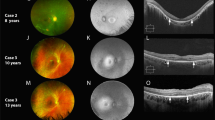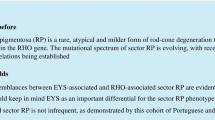Abstract
Purpose
To describe a series of patients with Stargardt disease (STGD1) exhibiting a phenotype usually associated with hydroxychloroquine (HCQ) retinopathy on spectral domain-optical coherence tomography (SD-OCT).
Methods
Observational case series from Columbia University Medical Center involving eight patients with genetically-confirmed STGD1. Patients selected for the study presented no history of HCQ use. Horizontal macular SD-OCT scans and accompanying 488-nm autofluorescence (AF) images, color fundus photographs, and full-field electroretinograms were analyzed.
Results
All study patients exhibited an abrupt thinning of the parafoveal region or disruption of the outer retinal layers on SD-OCT resembling the transient HCQ retinopathy phenotype. Funduscopy and AF imaging revealed variations of bull’s eye maculopathy (BEM). Five patients exhibited local fleck-like deposits around the lesion. Genetic screening confirmed two disease-causing ABCA4 mutations in five patients and one mutation in three patients.
Conclusions
A transient SD-OCT phenotype ascribed to patients with HCQ retinopathy is associated with an early subtype of STGD1. This finding may also present with HCQ retinopathy-like BEM lesions on AF imaging and funduscopy. A possible phenotypic overlap is unsurprising, given certain shared mechanistic disease processes between the two conditions. A thorough work-up, including screening of genes that are causal in retinal dystrophies associated with foveal sparing, may prevent misdiagnosis of more ambiguous cases.



Similar content being viewed by others
References
Michaelides M, Hunt DM, Moore AT (2003) The genetics of inherited macular dystrophies. J Med Genet 40(9):641–650
Allikmets R, Singh N, Sun H, Shroyer NF, Hutchinson A, Chidambaram A, Gerrard B, Baird L, Stauffer D, Peiffer A, Rattner A, Smallwood P, Li Y, Anderson KL, Lewis RA, Nathans J, Leppert M, Dean M, Lupski JR (1997) A photoreceptor cell-specific ATP-binding transporter gene (ABCR) is mutated in recessive Stargardt macular dystrophy. Nat Genet 15(3):236–246. doi:10.1038/ng0397-236
Weng J, Mata NL, Azarian SM, Tzekov RT, Birch DG, Travis GH (1999) Insights into the function of Rim protein in photoreceptors and etiology of Stargardt’s disease from the phenotype in abcr knockout mice. Cell 98(1):13–23. doi:10.1016/S0092-8674(00)80602-9
Quazi F, Molday RS (2014) ATP-binding cassette transporter ABCA4 and chemical isomerization protect photoreceptor cells from the toxic accumulation of excess 11-cis-retinal. Proc Natl Acad Sci U S A 111(13):5024–5029. doi:10.1073/pnas.1400780111
Fishman GA, Stone EM, Grover S, Derlacki DJ, Haines HL, Hockey RR (1999) Variation of clinical expression in patients with Stargardt dystrophy and sequence variations in the ABCR gene. Arch Ophthalmol 117(4):504–510
Noupuu K, Lee W, Zernant J, Tsang SH, Allikmets R (2014) Structural and genetic assessment of the ABCA4-associated optical gap phenotype. Invest Ophthalmol Vis Sci. doi:10.1167/iovs.14-14674
Cella W, Greenstein VC, Zernant-Rajang J, Smith TR, Barile G, Allikmets R, Tsang SH (2009) G1961E mutant allele in the Stargardt disease gene ABCA4 causes bull’s eye maculopathy. Exp Eye Res 89(1):16–24. doi:10.1016/j.exer.2009.02.001
Lois N, Holder GE, Bunce C, Fitzke FW, Bird AC (2001) Phenotypic subtypes of Stargardt macular dystrophy-fundus flavimaculatus. Arch Ophthalmol 119(3):359–369
Fujinami K, Sergouniotis PI, Davidson AE, Wright G, Chana RK, Tsunoda K, Tsubota K, Egan CA, Robson AG, Moore AT, Holder GE, Michaelides M, Webster AR (2013) Clinical and molecular analysis of Stargardt disease with preserved foveal structure and function. Am J Ophthalmol 156(3):487–501. doi:10.1016/j.ajo.2013.05.003, e481
Fishman GA (1976) Fundus flavimaculatus. A clinical classification. Arch Ophthalmol 94(12):2061–2067
Kanski JJBB (2011) Clinical ophthalmology. A systemic approach, 7th edn. Elsevier, Edinburg
Rodriguez-Padilla JA, Hedges TR 3rd, Monson B, Srinivasan V, Wojtkowski M, Reichel E, Duker JS, Schuman JS, Fujimoto JG (2007) High-speed ultra-high-resolution optical coherence tomography findings in hydroxychloroquine retinopathy. Arch Ophthalmol 125(6):775–780. doi:10.1001/archopht.125.6.775
Chen E, Brown DM, Benz MS, Fish RH, Wong TP, Kim RY, Major JC (2010) Spectral domain optical coherence tomography as an effective screening test for hydroxychloroquine retinopathy (the “flying saucer” sign). Clin Ophthalmol 4:1151–1158. doi:10.2147/OPTH.S14257
Marmor MF, Kellner U, Lai TY, Lyons JS, Mieler WF, American Academy of O (2011) Revised recommendations on screening for chloroquine and hydroxychloroquine retinopathy. Ophthalmology 118(2):415–422. doi:10.1016/j.ophtha.2010.11.017
Marmor MF (2012) Comparison of screening procedures in hydroxychloroquine toxicity. Arch Ophthalmol 130(4):461–469. doi:10.1001/archophthalmol.2011.371
Ascaso FJ, Rodriguez NA, San Miguel R, Huerva V (2013) The “flying saucer” sign on spectral domain optical coherence tomography in chloroquine retinopathy. Arthritis Rheum 65(9):2322. doi:10.1002/art.38063
Tailor R, Elaraoud I, Good P, Hope-Ross M, Scott RA (2012) A case of severe hydroxychloroquine-induced retinal toxicity in a patient with recent onset of renal impairment: a review of the literature on the use of hydroxychloroquine in renal impairment. Case Rep Ophthalmol Med 2012:182747. doi:10.1155/2012/182747
Marmor MF, Fulton AB, Holder GE, Miyake Y, Brigell M, Bach M, International Society for Clinical Electrophysiology of V (2009) ISCEV Standard for full-field clinical electroretinography (2008 update). Doc Ophthalmol 118(1):69–77. doi:10.1007/s10633-008-9155-4
Zernant J, Schubert C, Im KM, Burke T, Brown CM, Fishman GA, Tsang SH, Gouras P, Dean M, Allikmets R (2011) Analysis of the ABCA4 gene by next-generation sequencing. Invest Ophthalmol Vis Sci 52(11):8479–8487. doi:10.1167/iovs.11-8182
van Huet RA, Bax NM, Westeneng-van Haaften SC, Muhamad M, Zonneveld-Vrieling MN, Hoefsloot LH, Cremers FP, Boon CJ, Klevering BJ, Hoyng C (2014) Foveal sparing in Stargardt disease. Invest Ophthalmol Vis Sci. doi:10.1167/iovs.13-13825
Sparrow JR, Boulton M (2005) RPE lipofuscin and its role in retinal pathobiology. Exp Eye Res 80(5):595–606. doi:10.1016/j.exer.2005.01.007
Sparrow JR, Nakanishi K, Parish CA (2000) The lipofuscin fluorophore A2E mediates blue light-induced damage to retinal pigmented epithelial cells. Invest Ophthalmol Vis Sci 41(7):1981–1989
Kim SR, Nakanishi K, Itagaki Y, Sparrow JR (2006) Photooxidation of A2-PE, a photoreceptor outer segment fluorophore, and protection by lutein and zeaxanthin. Exp Eye Res 82(5):828–839. doi:10.1016/j.exer.2005.10.004
Lee W, Noupuu K, Oll M, Duncker T, Burke T, Zernant J, Bearelly S, Tsang SH, Sparrow JR, Allikmets R (2014) The external limiting membrane in early-onset Stargardt disease. Invest Ophthalmol Vis Sci 55(10):6139–6149. doi:10.1167/iovs.14-15126
Wang JS, Kefalov VJ (2011) The cone-specific visual cycle. Prog Retin Eye Res 30(2):115–128. doi:10.1016/j.preteyeres.2010.11.001
Boon CJ, Jeroen Klevering B, Keunen JE, Hoyng CB, Theelen T (2008) Fundus autofluorescence imaging of retinal dystrophies. Vis Res 48(26):2569–2577. doi:10.1016/j.visres.2008.01.010
Schmitz-Valckenberg S, Fleckenstein M, Helb HM, Charbel Issa P, Scholl HP, Holz FG (2009) In vivo imaging of foveal sparing in geographic atrophy secondary to age-related macular degeneration. Invest Ophthalmol Vis Sci 50(8):3915–3921. doi:10.1167/iovs.08-2484
Bernstein H, Zvaifler N, Rubin M, Mansour AM (1963) The ocular deposition of chloroquine. Invest Ophthalmol 2:384–392
Sundelin SP, Terman A (2002) Different effects of chloroquine and hydroxychloroquine on lysosomal function in cultured retinal pigment epithelial cells. APMIS 110(6):481–489
Mahon GJ, Anderson HR, Gardiner TA, McFarlane S, Archer DB, Stitt AW (2004) Chloroquine causes lysosomal dysfunction in neural retina and RPE: implications for retinopathy. Curr Eye Res 28(4):277–284
Burke TR, Duncker T, Woods RL, Greenberg JP, Zernant J, Tsang SH, Smith RT, Allikmets R, Sparrow JR, Delori FC (2014) Quantitative fundus autofluorescence in recessive Stargardt disease. Invest Ophthalmol Vis Sci 55(5):2841–2852. doi:10.1167/iovs.13-13624
Kellner U, Kellner S, Weinitz S (2008) Chloroquine retinopathy: lipofuscin- and melanin-related fundus autofluorescence, optical coherence tomography and multifocal electroretinography. Doc Ophthalmol 116(2):119–127. doi:10.1007/s10633-007-9105-6
Kellner U, Renner AB, Tillack H (2006) Fundus autofluorescence and mfERG for early detection of retinal alterations in patients using chloroquine/hydroxychloroquine. Invest Ophthalmol Vis Sci 47(8):3531–3538. doi:10.1167/iovs.05-1290
Kellner S, Weinitz S, Kellner U (2009) Spectral domain optical coherence tomography detects early stages of chloroquine retinopathy similar to multifocal electroretinography, fundus autofluorescence and near-infrared autofluorescence. Br J Ophthalmol 93(11):1444–1447. doi:10.1136/bjo.2008.157198
Gomes NL, Greenstein VC, Carlson JN, Tsang SH, Smith RT, Carr RE, Hood DC, Chang S (2009) A comparison of fundus autofluorescence and retinal structure in patients with Stargardt disease. Invest Ophthalmol Vis Sci 50(8):3953–3959. doi:10.1167/iovs.08-2657
Burke TR, Rhee DW, Smith RT, Tsang SH, Allikmets R, Chang S, Lazow MA, Hood DC, Greenstein VC (2011) Quantification of peripapillary sparing and macular involvement in Stargardt disease (STGD1). Invest Ophthalmol Vis Sci 52(11):8006–8015. doi:10.1167/iovs.11-7693
Shroyer NF, Lewis RA, Lupski JR (2001) Analysis of the ABCR (ABCA4) gene in 4-aminoquinoline retinopathy: is retinal toxicity by chloroquine and hydroxychloroquine related to Stargardt disease? Am J Ophthalmol 131(6):761–766
Zernant J, Collison FT, Lee W, Fishman GA, Noupuu K, Yuan B, Cai C, Lupski JR, Yannuzzi LA, Tsang SH, Allikmets R (2014) Genetic and clinical analysis of ABCA4-associated disease in African American patients. Hum Mutat 35(10):1187–1194. doi:10.1002/humu.22626
Financial support
This study was supported, in part, by grants from the National Eye Institute/NIH EY021163, EY019861, EY018213 and EY019007 (Core Support for Vision Research), Foundation Fighting Blindness (Owings Mills, MD), and unrestricted funds from Research to Prevent Blindness (New York, NY) to the Department of Ophthalmology, Columbia University.
Conflict of interest
All authors certify that they have no affiliations with or involvement in any organization or entity with any financial interest (such as honoraria; educational grants; participation in speakers’ bureaus; membership, employment, consultancies, stock ownership, or other equity interest; and expert testimony or patent-licensing arrangements), or non-financial interest (such as personal or professional relationships, affiliations, knowledge or beliefs) in the subject matter or materials discussed in this manuscript.
Author information
Authors and Affiliations
Corresponding author
Rights and permissions
About this article
Cite this article
Nõupuu, K., Lee, W., Zernant, J. et al. Recessive Stargardt disease phenocopying hydroxychloroquine retinopathy. Graefes Arch Clin Exp Ophthalmol 254, 865–872 (2016). https://doi.org/10.1007/s00417-015-3142-8
Received:
Revised:
Accepted:
Published:
Issue Date:
DOI: https://doi.org/10.1007/s00417-015-3142-8




